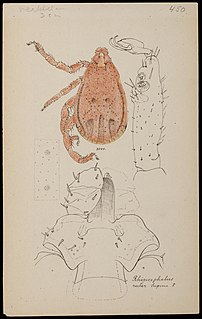
Amblyomma is a genus of hard ticks. Some are disease vectors, for example the Rocky Mountain spotted fever in Brazil or ehrlichiosis in the United States.

Amblyomma cajennense or Cayenne tick is a species of tick found in a range from the southern part of the United States to northern Argentina, through Central America and some of the Caribbean.

Amblyomma maculatum is a species of tick in the genus Amblyomma. Immatures usually infest small mammals and birds that dwell on the ground; cotton rats may be particularly favored hosts. Some recorded hosts include:

Hemolivia is a genus of the phylum Apicomplexia.
The Asian tortoise tick, is a hard-bodied tick of the genus Amblyomma. The tick is a parasite of tortoises, such as Geochelone elegans, domestic dogs, buffaloes. It is found in India, Sri Lanka and Myanmar. Adult tick is about 3 cm in length.
Amblyomma gervaisi is a hard-bodied tick of the genus Amblyomma. The tick is a parasite of snakes, such as Naja naja, Python molurus species and monitor species such as Varanus ocellatus, Varanus yemenensis, Varanus benghalensis, Varanus griseus and many other Varanus species in southeastern Asia and Asia-minor. They exhibit sexual dimorphism. They can be found in Sri Lanka, India, Yemen, Saudi Arabia. It is a potential vector for Coxiella burnetii.
Amblyomma integrum is a hard-bodied tick of the genus Amblyomma. It is found in India and Sri Lanka. Adults parasitize various larger mammals such as buffalo and cattle, whereas nymphs and larvae use mostly larger and medium mammals. In Sri Lanka, tick was identified as an agent of human otoacariasis.
Amblyomma javanense is a hard-bodied tick of the genus Amblyomma. It is found in Vietnam, Indonesia, Malaysia, India, Sri Lanka, Philippines and Thailand. It is the only ectoparasite found on the Manis javanica, Manis crassicaudata and also from Sus scrofa.

Amblyomma testudinarium is a hard-bodied tick of the genus Amblyomma. It is found in Indonesia, India, Japan, Thailand, Sri Lanka and Vietnam. Adults parasitize various larger mammals such as buffalo and cattle, whereas nymphs and larvae use mostly larger and medium mammals.
The Asian monitor lizard tick, is a hard-bodied tick of the genus Amblyomma. It is found in India, Thailand, Taiwan and Sri Lanka. Adults parasitize various reptiles such as varanids and snakes. These ticks are potential vectors of spotted fever group (SFG) rickettsiae.
Ixodes petauristae is a hard-bodied tick of the genus Ixodes. It is found in India and Sri Lanka. Adults parasitize various smaller mammals such as Ratufa indica, Funambulus tristriatus, Macaca radiata, Petaurista sp. and mice. It is a potential vector of Kyasanur Forest disease virus,
Ixodes ceylonensis is a hard-bodied tick of the genus Ixodes. It is found in India and Sri Lanka. It is an obligate ectoparasite of mammals.
Haemaphysalis aculeata is a hard-bodied tick of the genus Haemaphysalis. It is found in India and Sri Lanka.
Haemaphysalis bispinosa is a hard-bodied tick of the genus Haemaphysalis. It is found in India, Sri Lanka, Myanmar, Pakistan, Nepal, Australia, and Indonesia. It is an obligate ectoparasite of mammals. It is a potential vector of Kyasanur Forest disease virus. These ticks was found parasitized by a chalcid Hunterellus sagarensis in these diseased areas.
Haemaphysalis cuspidata is a hard-bodied tick of the genus Haemaphysalis. It is found in India and Sri Lanka. It is a potential vector of Kyasanur Forest disease virus.
The Flat-inner-spurred haemaphysalid,, is a hard-bodied tick of the genus Haemaphysalis. It is found in India and Sri Lanka. It is an obligate ectoparasite of mammals. It is a potential vector of Kyasanur Forest disease virus, Ganjam virus, and Nairobi sheep disease virus.

Rhipicephalus haemaphysaloides is a hard-bodied tick of the genus Rhipicephalus. It is one of the major medically important ticks in the world.

Amblyomma sphenodonti or the tuatara tick is a species that parasitises only the tuatara of New Zealand, and is not closely related to any other tick. It is found on just four of the twelve island groups where tuatara survive, preferring islands where the reptiles live in high densities. Larvae, nymphs, and adults all feed exclusively on tuatara blood, and ticks can survive for up to a year without a host. When tuatara are translocated, the tick has been lost or survives only in low densities in the new population.

Lotilaner is a veterinary drug used to control fleas and ticks in dogs. It is indicated for the treatment and prevention of flea infestations and for the treatment and control of tick infestations including lone star tick, American dog tick, black-legged tick, and brown dog tick.








